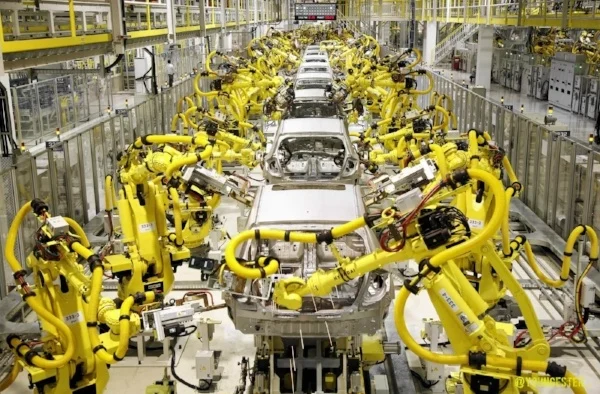Revolutionizing Manufacturing: The Role of Robotics in Industry
- Tayyeb Momin
- Jul 10, 2023
- 4 min read
Updated: Jul 13, 2023

Welcome! In this inaugural article, let's delve into a topic that is reshaping the manufacturing landscape: robotics. Over the years, advancements in technology have led to remarkable developments in the field of robotics, and its integration into manufacturing processes has proven to be a game-changer. In this article, we will explore how robotics is revolutionizing the manufacturing industry, unlocking new possibilities, and boosting productivity.
1. Enhanced Efficiency and Productivity
Robotics has ushered in a new era of efficiency and productivity in manufacturing. Industrial robots are capable of executing repetitive tasks with unparalleled precision and speed, consistently maintaining high levels of accuracy. This eliminates human errors and fatigue, leading to improved product quality and increased output. With robots taking over mundane and repetitive tasks, human workers can focus on more complex and creative aspects of the manufacturing process, leading to a significant increase in overall productivity. Case Study: Tesla's Gigafactory
One notable example of robotics' impact on manufacturing efficiency is Tesla's Gigafactory in Nevada, USA. The Gigafactory is a state-of-the-art facility that produces lithium-ion batteries for Tesla's electric vehicles. It is equipped with an extensive fleet of robots that automate various stages of the battery production process. These robots work tirelessly, assembling battery cells, modules, and packs with incredible precision and speed. The integration of robotics has enabled Tesla to achieve unmatched levels of productivity and scale, playing a crucial role in the company's rapid growth and dominance in the electric vehicle market.

2. Cost Reduction and Increased Competitiveness
The integration of robots in manufacturing processes can significantly reduce costs associated with labor, training, and employee benefits. While the initial investment in robotics may seem substantial, the long-term benefits outweigh the expenses. Robots can work round the clock without the need for breaks or vacations, resulting in increased production uptime and reduced downtime. This enhanced efficiency translates into cost savings and improved profitability, ultimately making manufacturing companies more competitive in the global market.
Case Study: Adidas Speedfactory
Adidas, a renowned sports apparel company, embarked on an innovative manufacturing initiative called the Speedfactory. These facilities, located in Germany and the United States, utilize advanced robotics to automate the shoe production process. By incorporating robots, Adidas significantly reduced labor costs, streamlined production timelines, and minimized waste. The Speedfactory concept exemplifies how robotics can contribute to cost reduction, making manufacturing operations more competitive in a global market.
3. Improved Safety for Workers
Safety is a top priority in any manufacturing environment. By deploying robots for hazardous tasks, such as handling heavy machinery or working in dangerous conditions, manufacturers can ensure the safety and well-being of their workers. Robots are designed to operate in hazardous environments, reducing the risk of accidents and injuries. Additionally, human workers can be relocated to safer positions that require critical thinking and decision-making skills, resulting in a safer and more harmonious work environment.
Case Study: BMW's Collaborative Robots
BMW, a leading automotive manufacturer, has implemented collaborative robots in its factories to enhance worker safety. These robots work alongside human employees, performing physically demanding tasks such as lifting heavy parts or assisting with intricate assembly processes. By taking on these potentially hazardous tasks, robots reduce the risk of injuries and promote a safer work environment. BMW's use of collaborative robots demonstrates how robotics can prioritize employee well-being while increasing productivity.
4. Flexibility and Adaptability
One of the significant advantages of robotic systems in manufacturing is their flexibility and adaptability. With advanced programming and machine learning capabilities, robots can quickly adapt to changes in production requirements, allowing for seamless transitions between different tasks and product variations. This agility provides manufacturers with the ability to respond rapidly to market demands, customize products efficiently, and reduce time-to-market, ultimately giving them a competitive edge.
Case Study: Fanuc's Intelligent Robots
Fanuc, a Japanese robotics company, has developed intelligent robots that possess exceptional flexibility and adaptability. These robots are capable of quickly transitioning between different manufacturing tasks, reducing downtime and maximizing efficiency. Fanuc's robots have been deployed across various industries, including automotive, electronics, and food production. The ability to adapt to changing production requirements allows manufacturers to stay agile and responsive in the face of evolving market demands.
5. Collaboration Between Humans and Robots
Contrary to popular belief, robotics in manufacturing does not replace human workers entirely; rather, it complements their skills and expertise. Collaborative robots, also known as cobots, are designed to work alongside human workers, enhancing their capabilities and productivity. Cobots are equipped with advanced sensors and safety features that allow them to interact with humans safely. This collaboration between humans and robots maximizes efficiency by leveraging the strengths of both, ultimately leading to higher productivity and improved quality.
Case Study: Universal Robots and Biesse Group
Universal Robots, a leading manufacturer of collaborative robots (cobots), partnered with Biesse Group, an Italian company specializing in woodworking machinery. Together, they revolutionized the furniture manufacturing process. Cobots were integrated into Biesse Group's production lines, working alongside human operators to perform intricate tasks such as sanding, drilling, and milling. The collaboration between humans and robots resulted in higher production rates, improved precision, and reduced physical strain on workers.

Conclusion
The integration of robotics in manufacturing is transforming the industry at an unprecedented rate. From Tesla's Gigafactory to Adidas' Speedfactory and BMW's collaborative robots, these case studies highlight the substantial benefits of incorporating robotics into manufacturing processes. With their exceptional precision, speed, and adaptability, robots have become invaluable assets to manufacturers worldwide. From enhancing productivity and efficiency to ensuring worker safety and reducing costs, the benefits of robotics in manufacturing are numerous. As we embrace the era of automation, it is crucial for manufacturers to stay abreast of the latest developments and explore opportunities for incorporating robotics into their operations. The future of manufacturing is here, and it is driven by the power of robotics.







Comments